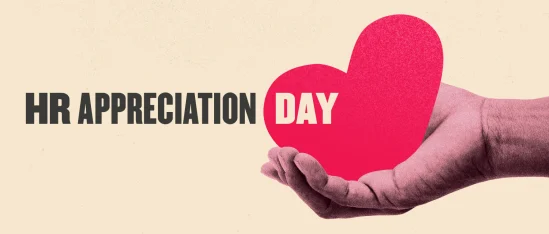When you hear that September 26 is HR Appreciation Day, you might be excited and think, “Hooray, we are finally going to get some thanks for the long hours, tireless work, and invisible impact we make day in and day out.”
Instead, I challenge you to think of this day as the launchpad for a new normal. Imagine a world where you and your colleagues regularly feel appreciated and share appreciation for others.
Let’s get real about HR burnout
Over the last decade (especially since COVID), organizations have depended on HR to provide solutions to everything from doing more with less, retaining key talent, and supporting employee health and wellbeing at scale. With the burden on HR’s shoulders and a growing list of expectations and responsibilities, it’s no surprise that burnout levels are through the roof.
HR forums are buzzing with conversations about the unprecedented levels of burnout (especially among HR professionals): 81 percent feel regularly burned out, and 95 percent feel overwhelmed by their workload and stress levels. Furthermore, 91 percent of HR leaders describe their profession as having radically transformed over the last five years and anticipate further frequent changes.
As an HR professional, how can you overcome burnout, return to your baseline, and—even more importantly—arrive at a place where your work with people energizes you and brings you joy?
What matters most is considering how you can shift your mindset and your actions to give yourself and the teams around you the power to stay engaged, productive, and innovative as you navigate the highs and lows of life and work.
The key to shifting your mindset starts with understanding appreciation as a verb and the need to take intentional action.
Appreciation as a verb
The Merriam-Webster dictionary definition of appreciation is “a feeling or expression of admiration, approval, or gratitude.”
To appreciate someone means actually doing something that shows them you acknowledge and value their impact.
When it comes down to it, little tokens of appreciation over time matter so much more than a grand gesture, which people may see as too little too late.
The proof is in the data
Appreciation starts with acknowledging specific individuals and teams that have had a positive impact on your employee experience—and tying these moments of appreciation directly or indirectly to the business’s bottom line.
According to Gallup research, cultures of recognition are low-cost and high-gain with 45 percent of well-recognized employees less likely to leave the company over the next two years.
In fact, more research on the ROI of appreciation and recognition highlights the connection between recognition and performance. Companies with people who receive regular appreciation show 21 percent greater profitability and 17 percent higher productivity.
Recommended For Further Reading
Bring the spirit of appreciation into everyday
As we pause to celebrate and appreciate HR people, let’s think more about why and how to bring the spirit of HR Appreciation Day into each day of the year.
Right now, the HR collective mindset tends towards thoughts like, “I’m in this thankless role of HR, and it’s all on me.” To take the pressure off and commit to giving credit to ourselves and the people around us, we can start by evolving those thoughts into something like, “We are in the privileged position of becoming the center of influence and creating a ripple effect for others.”
It might help to understand that the act of sharing appreciation has multiple positive effects on our brains and bodies. Like “sharing the love,” everyone benefits when we share appreciation.
The feeling of appreciation and recognition can trigger the release of dopamine, activating the brain’s reward system. It can also release oxytocin, which helps us feel more connected to each other and even reduces stress by building positive neural pathways.
Appreciation is the cornerstone of a thriving workplace, and cultures of recognition help us build stronger teams, increase engagement and performance, and promote collective wellbeing.
Appreciation starts with you
As HR professionals, we role model organizational leadership. Self-appreciation is key.
Here are a few practical examples of how you can set a positive example, model self-appreciation, and inspire others to do the same:
- Write yourself a daily or weekly “Have done” list to celebrate your wins.
- Reflect on moments you are proud of. You can do this with a buddy or privately.
- Commit to daily or weekly gratitude journaling.
- Invest in your own development in areas that you care about. I recently invested in some parenting support, and it’s felt like a significant acknowledgement of my family role in parallel to my professional responsibilities.
- Solicit feedback (make it specific) around themes that matter to you and from people whose opinions you value. This can apply to your work and personal life!
- Lastly, think about behaviors or milestones that you want to reward in little but personally gratifying ways. For example, I love saving my morning coffee until after I’ve eaten my “frog” of the day.
Building on this, you can promote a culture of appreciation and recognition that spreads further.
Who needs to know what works for you?
Modeling self-appreciation and encouraging everyone in the organization to “spread the love” is key to creating a culture where everyone feels valued. But appreciation is personal. What makes one person feel valued might not resonate with someone else.
To successfully model self-appreciation as a practice others can follow and become a center of influence at your organization, it’s important to recognize what kind of appreciation resonates with you. Then, tell your manager and teammates what it is.
From there, it’s important to take the time to understand your people’s individual needs and preferences—and to encourage your people to do the same.
Similar to what Gary Chapman discusses in his book, The Five Love Languages, you might prefer words of affirmation, gifts, public or private praise, quality time for yourself or with people you care about, or even help with something that would lighten your workload.
As people professionals serving as centers of influence, it’s up to us to encourage our colleagues in HR, company leadership, people managers, and individual contributors to identify what forms of recognition and appreciation resonate most with them and to share those with each other.
Spread the love
More than anything, becoming a center of influence means helping people understand how much of an impact they have on their organization’s culture and the business. We all need to be talking about it.
Opportunities to weave appreciation and recognition into the fabric of your company culture could include practices that link appreciation to the shared bigger picture:
- Write personalized thank-you notes.
- Award virtual badges to celebrate milestones and recognize expertise.
- Create micro-moments to acknowledge achievements and learnings, like sending a gift for work anniversaries, awarding bonuses, or initiating events where the team can enjoy being together.
- Publicly share stories of people’s impact (town halls, team meetings, Shoutouts, newsletters, bulletins, social media posts, etc.)
Whichever act you choose, remember to link the action to impact. Remember, little and often goes a long way and pays dividends over time, especially when you’re consistent about it.
So, on this day of HR Appreciation, there are so many reasons to commit to acts of appreciation that can develop a culture of recognition all year round.
There are so many reasons to share the love.


